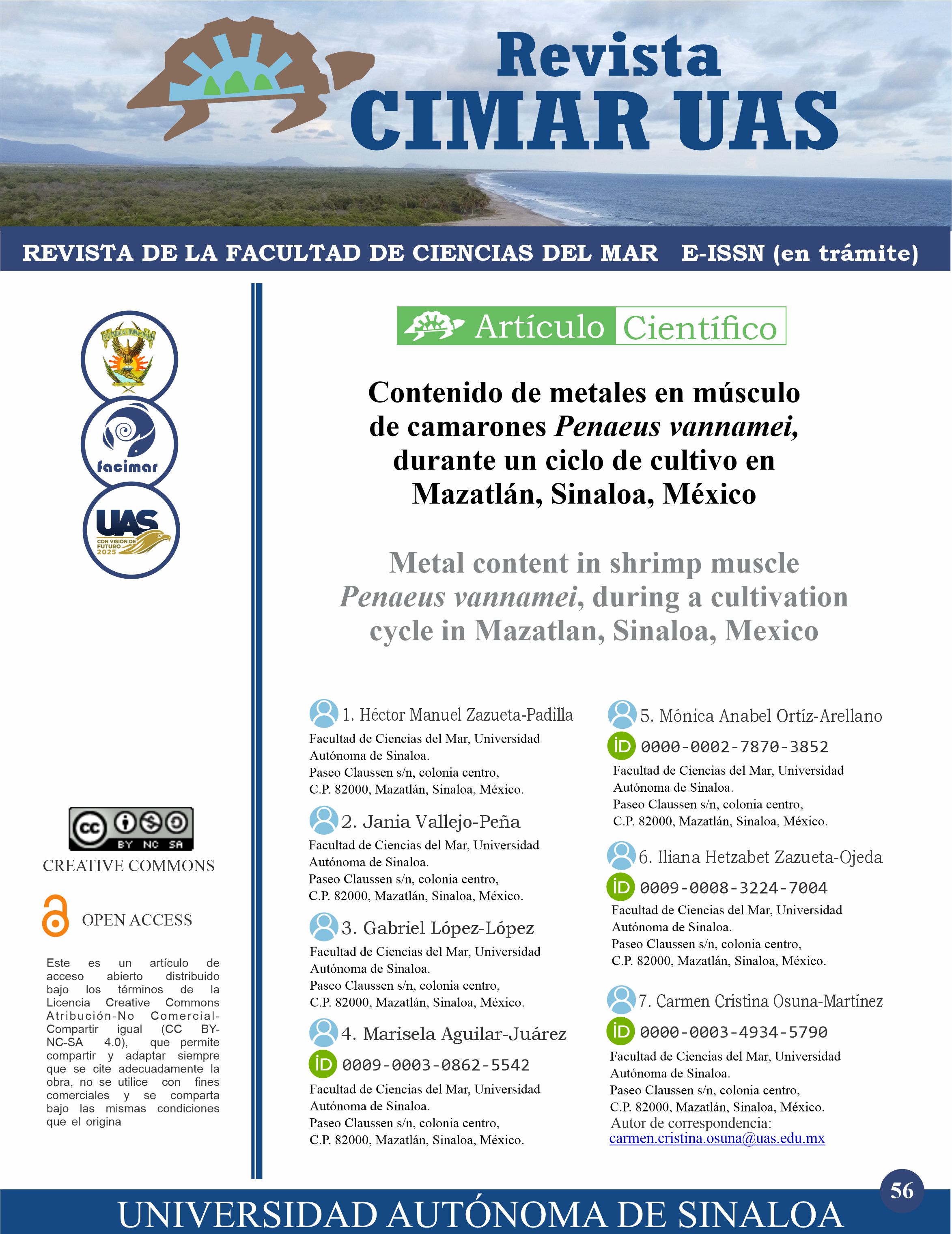Metal content in shrimp muscle Penaeus vannamei, during a cultivation cycle in Mazatlán, Sinaloa, México.
Keywords:
aquaculture, shrimp farming, heavy metals, essential metals, edible tissueAbstract
This study was carried out with the objective of evaluating the concentrations of metals (cadmium, cobalt, copper, chromium, iron, manganese, nickel and zinc) present in the abdomen (muscle or edible tissue) of specimens of the white shrimp Penaeus vannamei (Boone, 1931), collected during a culture cycle (four months) on a shrimp farm in Mazatlán, Sinaloa, Mexico. Weekly, samples of shrimp into batches of 30 to 40 organisms were obtained, separated by size in intervals of one centimeter (from 5-6 to 15-16 cm). Once processed in the laboratory, the concentration of metals was determined by atomic absorption spectrophotometry. In the results, it was observed that the essential elements were found in higher concentration than cadmium (non-essential). Regarding the health risk, Zn is the metal that would limit its consumption, although around 1 kg/day would have to be consumed to represent a risk; therefore, it is concluded that the consumption of L. vannamei shrimps grown on that farm does not imply a risk (due to ingestion of these metals) to human health.
Downloads
References
Amaraneni, S. R. (2006). Distribution of pesticides, PAHs and heavy metals in prawn ponds near Kolleru lake wetland, India. Environment International, 32, pp. 294-302. doi: https://doi.org/10.1016/j.envint.2005.06.001
Benson, J. M. & Zelikaff, J. T. (1996). Respiratory toxicology of metals. En L. W. Chang (Ed.), Toxicology of metals (pp. 929-938). Tokyo: Lewis Publisher.
Castañé, P. M., Topalián, M. L., Cordero, R. & Salibián, A. (2003). Influencia de la especiación de los metales pesados en medio acuático como determinante de su toxicidad. Revista de Toxicología, 20, pp. 13-18.
Carbonell, G., Ramos, C. & Tarazona, J.V. (1998). Heavy metals in shrimp culture areas from Gulf of Fonseca, Central America. II. Cultured shrimp. Bulletin of Environmental Contamination and Toxicology, 60, 260-265. doi: https://doi.org/10.1007/s001289900619
Chou, C. L., Hay, K., Paon, L., Burridge, A. & Moffat, J. D. (2002). Aquaculture-related trace metals in sediments and lobster and relevance to environmental monitoring program ratings for near-filed effects. Marine Pollution Bulletin, 44, pp. 1259-1268. doi: https://doi.org/10.1016/S0025-326X(02)00219-9
Hagner-Holler, S., Kusche, K., Hembach, A. & Burmester, T. (2005). Biochemical and molecular characterization of hemocyanin from the amphipod Gammarus roeseli. Journal of Comparative Physiology, 175B, pp. 445-452. doi: https://doi.org/10.1007/s00360-005-0012-4
Keogh, J.P. & Siegers, C. P. (1996). Influences on the gastrointestinal system by essential and toxic metals. En L.W. Chang (Ed.) Toxicology of metals (pp. 901-919). Tokyo: Lewis Publisher.
Manisseri, M.K. & Menon, N. R. (1995). Copper-induced damage to the hepatopáncreas of penaeid shrimp Metapenaeus dobsoni – an ultrastructural study. Disease of Aquatic Organisms, 22, pp. 51-57. doi: https://doi.org/10.3354/dao022051
Martínez-Tabche, L., Gómez-Oliván, L., Martínez, M., Castillo, C. & Santiago, A. (2000). Toxicity of nickel in artificial sediment on acetyl cholinesterase activity and hemoglobin concentration of the aquatic flea, Moina macrocopa. Journal of Environmental Hydrology, 8, pp. 1-10.
Moody, J.R. & Lindstrom, R. N. (1977). Selection and cleaning of plastic containers for storage of trace element sample. Analytical Chemistry, 49, 2264-7. doi: https://doi.org/10.1021/ac50022a039
Osuna-López, J.I., Páez-Osuna, F., Frías-Espericueta, M. G., López-López, G., Izaguirre-Fierro, G. & Zazueta-Padilla, H. M. (2003). Monitoreo de metales pesados en sedimentos y camarones cultivados (Litopenaeus stylirostris y Litopenaeus vannamei) en granjas camaronícolas del noroeste de México. CONACYT 32501-T.
Páez-Osuna, F. & Ruiz-Fernández, C. (1995). Comparative bioaccumulation of trace metals in Penaeus stylirostris in estuarine and coastal environments. Estuarine Coastal and Shelf Science, 40, pp. 35-44. doi: https://doi.org/10.1016/0272-7714(95)90011-X
Páez-Osuna, F. & Tron-Mayen, L. (1996). Concentration and distribution of heavy metals in tissues of wild and farmed shrimp Penaeus vannamei from the northwest coast of Mexico. Environment International, 22, pp 443-450. doi: https://doi.org/10.1016/0160-4120(96)00032-3
Páez-Osuna, F. & Frías-Espericueta, M. G. (2001). Bioacumulación, distribución y efectos de los metales pesados en los Peneidos. En F. Páez-Osuna (Ed.), La Camaronicultura y el Medio Ambiente (pp. 244-270). México: UNAM y El Colegio de Sinaloa.
Palomarez-García, J. M., Castañeda-Chávez, M., Lango-Reinoso, F. & Landeros-Sánchez, C. (2009). Niveles de metales pesados en camarón café Farfantepenaeus aztecus de la laguna de Tamiahua, Veracruz, México. Revista de Investigaciones Marinas, 30, pp. 63-69.
Pourang, N., Dennis, J. H. & Ghourchian, H. (2004). Tissue distribution and redistribution of trace elements in shrimp species with the emphasis on the roles of metallothionein. Ecotoxicology, 13, pp. 519-533. doi: https://doi.org/10.1023/B:ECTX.0000037189.80775.9c
Quintero-Álvarez, J.M., Soto-Jiménez, M. F., Amezcua, F., Voltolina, D. & Frías-Espericueta, M. G. (2012). Cadmium and lead concentrations in the fish tissues of a coastal lagoon system of the SE Gulf of California. Bulletin of Environmental Contamination & Toxicology, 89, pp. 820-823. doi: https://doi.org/10.1007/s00128-012-0730-8
Soderberg, L. S. F., Sorenson, J. R. J. & Chang, L. W. (1996). Modulation of immune functions by metallic compounds. En L.W. Chang (Ed.) Toxicology of metals (pp. 871-884). Tokyo: Lewis Publisher.
Woods, J. S. (1996). Effects of metals on the hematopoietic system and heme metabolism. En L.W. Chang (Ed.) Toxicology of metals (pp. 939-958). Tokyo: Lewis Publisher.
Wu, X. Y. & Yang, Y. F. (2011). Heavy metal (Pb, Co, Cd, Cr, Cu, Mn and Zn) concentrations in harvest-size white shrimp Litopenaeus vannamei tissues from aquaculture and wild source. Journal of Food Composition and Analysis, 24, pp. 62-65. doi: https://doi.org/10.1016/j.jfca.2010.03.030

Downloads
Published
Data Availability Statement
As of Jun 26, the references and links of the article were available for verification.

 Cada manuscrito está bajo la licencia Atribución-NoComercial-SinDerivadas 4.0 Internacional (CC BY-NC-ND 4.0)
Cada manuscrito está bajo la licencia Atribución-NoComercial-SinDerivadas 4.0 Internacional (CC BY-NC-ND 4.0) 